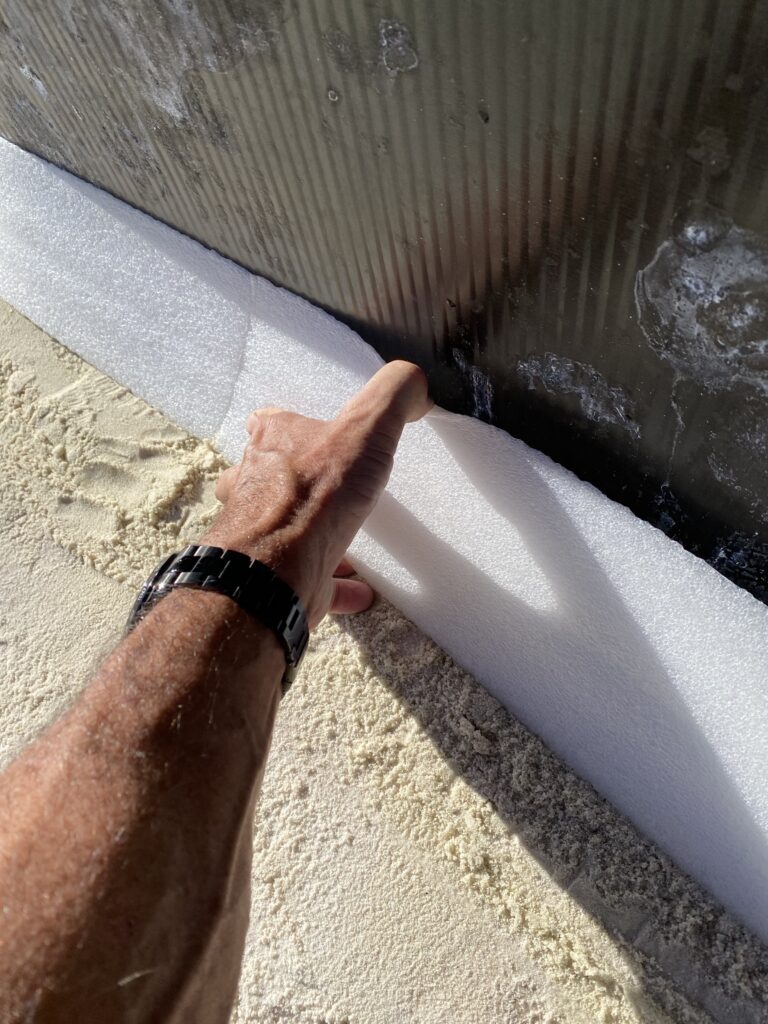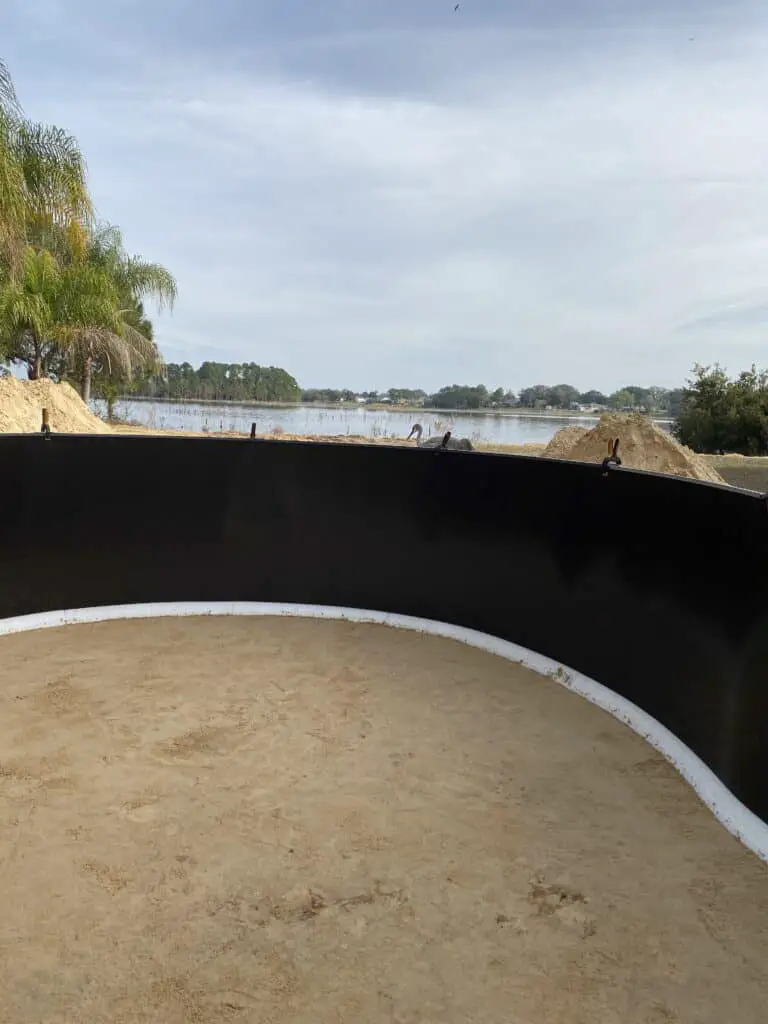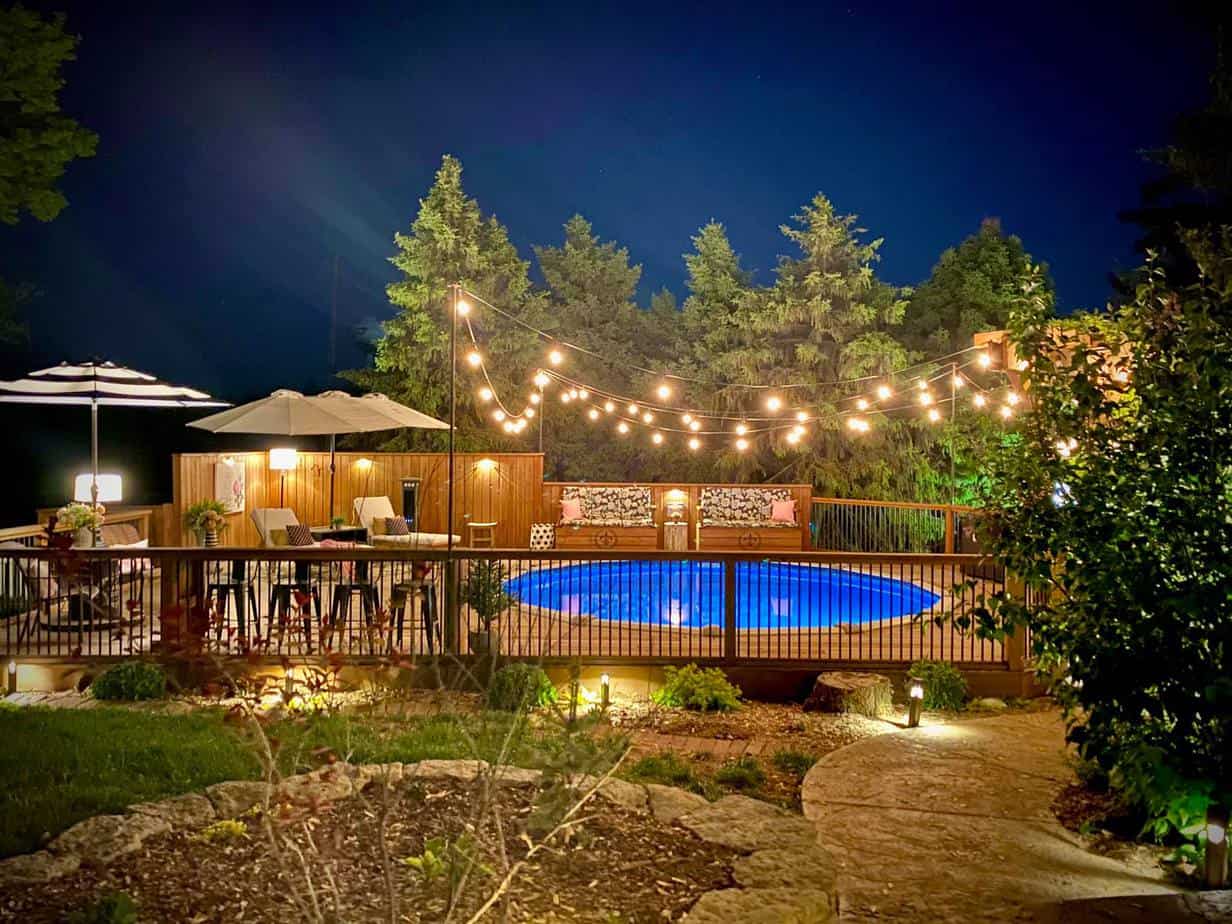
When installing an above ground swimming pool, there has to be a transition between the bottom of the inside of the pool wall and the floor of the pool. You can’t just have a sharp angle where the two meet, so an embankment or coving has to be applied. This is called pool cove or coving.
WHY IS A POOL COVE NEEDED?
As a pool installer for more than three decades and a fairly smart guy, I only know of two reasons coving is needed for the proper installation of an above-ground swimming pool. There may be some nerdy or engineering reason or explanation for coving, but that won’t be covered or considered here. If you want that, I’m sure there are a few “internet pros” out there with pillow-soft hands and rosy cheeks that can explain it to you.
Pool cove helps distribute outward and downward pressure from water weight
An above ground swimming pool is usually at ground level. This means that the water from the pool is held in only by the wall of the pool and not the surrounding earth (like it would be supported if it was in the ground some).
Now, water is heavy. A gallon of water weighs 8.34 pounds (3.78 kilograms for those not in the US). The overall weight of an above ground pool can really be heavy. A 24’ round pool (which is the most common size) holds about 14,000 gallons. Times 14k by 8.34 and you get more than 115,000 pounds. This is a lot of weight. For all you rednecks out there, that’s about the weight of 25 Ford F-150s.
Above ground pools are a big cylinder of water that has a lot of outward and downward pressure. The outward pressure (pushing out from the pool’s wall) increases at you get to the bottom of the pool. This means that the greatest outward pressure is at the very bottom of the wall.
To help alleviate all that outward pressure at the bottom of the wall, a coving or embankment is placed all around the pool’s bottom going up the wall. This relieves some of that pressure by transitioning it from the bottom of the wall to the pool’s floor. Are you still with me, or did I lose you?
An above ground pool doesn’t absolutely need a coving. I only say that because I’ve seen a few (maybe 3 in thirty years) above grounds without one and were up for several years. I wouldn’t have believed it if I didn’t see it for myself. Personally, I wouldn’t get near an AG pool without coving.
Pool cove protects the liner from the bottom track
This isn’t as big and badass a reason as number one, but it’s valid.
Bottom tracks and connectors on above ground pools can have sharp edges that do not sit perfectly in place. Because of this, you don’t want the liner touching or near those parts. The above ground pool cove covers the bottom track well which protects the liner from getting rips or holes in it.
OPTIONS FOR ABOVE GROUND POOL COVING
Making a cove for an above ground pool installation is pretty straightforward, so you don’t have many choices. There really are only two.
With most of the installs I have done over the years, I have used the earth to make a cove with. This is just a manner of taking some of the dirt from the pool’s earth bottom and making an embankment upward and along the bottom of the pool wall. If the earth is too hard, then send is brought in to be used to make the cove (as well as leveling the pool bottom).
The only real question when using sand or earth for coving is how big should I make the above ground pool cove? Way back in the 1980s and early 90s, I used to make a rather big cove for pools. Maybe going six to eight inches up the pool wall. Lately though (meaning in the last twenty years), I usually make my coving about four to six inches up the wall and out from the wall.
I have learned that in most cases, a bigger cove is not necessary. If you are DIYing it though, it’s better to make the coving bigger than smaller. A bigger cove is better just in case you screw something else up with the install.
I recommend wetting down and tamping your earth or sand cove. You want to make sure the cove is nicely packed in.
The other option you have for coving is a thing called foam coving.
WHAT IS FOAM COVING?


Although the product available called “pool foam coving” has been around for more than twenty years, I am old enough to remember when it didn’t exist.
Many years ago, when they used to deliver milk, above ground pool installers could only use sand or earth for their coving. Then, to solve the problem of installing pools on concrete in retail showrooms, the foam cove was invented.
Using sand for coving for pools on indoor display didn’t work too well. The sand might escape some and make a bit of a mess in showrooms. So, someone non-famous came up with the idea of getting long strips of foam triangles maybe 6” by 6” and use that for the display pools. They wouldn’t come apart and make a mess and look nice and uniform when customers looked in at the full pool. And so, the pool foam cove came to be.
For some years, the foam cove was only used on pools that were installed on concrete. Eventually, retailers started selling it with pools that went on the earth as well. At first, I thought it was stupid. I had been an installer for years and the earth cove was fine. Why add an unnecessary product? I mean, it was a great idea for concrete bottom pools, but a waste of money for a pool on the ground.
Some years went by and the foam cove gained some popularity, and I eventually accepted the idea. Now, I would say that about twenty percent of the pools that I install have a foam coving.
SHOULD I BUY FOAM COVING FOR MY ABOVE GROUND POOL?

As a trusted pool installer, I get asked all the time whether or not they should buy foam cove for their above ground pool. My answer from years ago was a hard “no” as I didn’t like the idea of adding a product that was unnecessary.
Lately though (meaning in the last ten years or so), my opinion is to get the foam cove only if it’s in your above ground pool purchase budget to do so. For what it really is, it’s pretty expensive. Expect to pay around $100 for a common size above ground (24’ round) for some long triangles of foam pieces. It may not seem like a lot of money when making a two to four thousand dollar purchase. But you will be adding something you don’t need, so that’s a thing.
If you are planning on installing the pool yourself, I guess I would recommend getting foam coving (along with a liner guard). It’s almost impossible to install wrong and will guarantee that the pool will have a sufficient coving, which I think is important.
PROS AND CONS TO GETTING POOL FOAM COVING
PROS
1 Makes for a more uniform, smoother cove which looks and feels better
2 Decreases the margin for error with DIYers
3 Won’t wash away if there is a leak near or at the pool wall
CONS
1 Adds to the cost of the pool
2 May have to be replaced when replacing the liner (but usually not)
Read next – What is a liner guard?

I dont think I added enough coving to one said of the pool an it has a small leak the pool is full how can I fix it ? Or is it to late
I don’t know. You haven’t given me enough info on the leak. Sorry.
Hi Dan,
You have some great and easily understandable information here. Thank you. I would like your advice about the following materials before the work is started next week.
We have a 24*12 rectangular Intex soft sided pool that we are putting 2 ft into the ground. The hole is 2 ft wider than the pool all the way around. Our pool guy has suggested that we use Quarter minus which is self-leveling the base rather than trying to make the ground perfectly level. I haven’t read anything about using this for under a pool. Will this work? I have the ground cover that came with the pool as well as a 15 ft round gorilla pad from a previous pool. I was thinking we should also add foam tiles or sheets on top to protect the pool liner.
Hi. I’m sorry for the delay as you’ve probably already done the project. If this is what the guy wants to use to level the bottom of the hole, then it’s OK. Personally, I would use sand if your earth is hard to level. And you should really only need the old pad to put down just in case the quarter stone feels hard on your feet while in the pool.